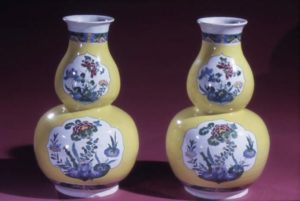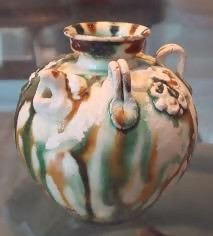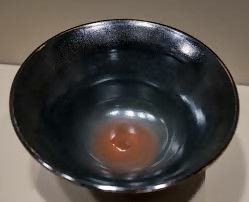I was asked recently – what do you do after molding your ceramics? You glaze them! Glazing adds a safe, sealed coating to your bisque-fired wares– thereby making your creations waterproof and food safe. It also brings life to your work and it also brings your work to life with any color you wish to create. Glazing is that finishing touch you add to your piece to make is distinct and unique from all other artists’ wares. The creative possibilities of glazing are infinite and the techniques and patterns you can create with them have no limit. Glazing can take an ordinary ceramic ware and make it an exquisite work of art.
As earlier said, glazing can turn an ordinary clay piece to an astonishing work of art, but in the same vein, improper glazing techniques can ruin a piece. That is why it is advisable to spend a bit of time planning and picturing the exact look, feel and color of what you want to achieve. Various glazes and clays have different properties, so you should put that into consideration before you begin the glazing process. As you know, glazes are responsible both for decorating the pottery and for crafting an attractive glossy surface that protects the pottery from wear, tear, and water. Glazing is a long and elaborate process, although it is not too hard to learn, and your results will improve with constant practice.
IS GLAZING ESSENTIAL IN MY POTTERY?
Pottery pieces become artworks when they are decorated and glazed carefully. Tinges are used to decorate the pottery wares once they have been fired in a kiln for some time and they turned into bisque. Glazing is said to be the final step after decorating your piece. Depending on the formula of the glaze, there are many different results once the piece goes through its final firing. Glazes can be structured to turn a piece matte or glossy. Glazing can also produce coloring when fired.
WHY DO I NEED TO GLAZE MY POTTERY?
- Decoration
 I don’t have to emphasize o how beautiful and attractive glazing makes pottery look. Glazes are silica-based glass constituents that create a smooth, fine glass surface over clay when it is melted at high temperatures. Oxides are used both under and over applications of clear glass glaze for coloration and decoration. Today, different oxides are often mixed with other glaze chemicals and available for potters at ceramic supply stores and online. These products are called underglazes (for application under a glassy glaze) or overglaze (applied on top of a glaze and refired.) Each one has a different decorative outcome. Summarily, gazes are used for decorative purposes. There are underglaze and overglaze when they mixed with water and painted on pottery with brushes to attain a pen-and-ink effect that resists firing at high temperatures.
I don’t have to emphasize o how beautiful and attractive glazing makes pottery look. Glazes are silica-based glass constituents that create a smooth, fine glass surface over clay when it is melted at high temperatures. Oxides are used both under and over applications of clear glass glaze for coloration and decoration. Today, different oxides are often mixed with other glaze chemicals and available for potters at ceramic supply stores and online. These products are called underglazes (for application under a glassy glaze) or overglaze (applied on top of a glaze and refired.) Each one has a different decorative outcome. Summarily, gazes are used for decorative purposes. There are underglaze and overglaze when they mixed with water and painted on pottery with brushes to attain a pen-and-ink effect that resists firing at high temperatures.
- Waterproofing
I think it is quite obvious that water is the poison of any form of pottery. But the antidote to this poison is glazing. Glaze melts and flows evenly over an object when heated with temperatures between 1800 and 2400 degrees F–in a ceramics kiln. The glaze melts and it coats the surfaces evenly with a thin coating of glass. As the glass cools slowly, the glazed surface turns smooth and solid. The result is a tight surface that is water-resistant and holds liquids effectively over time. You must be careful when you are coordinating the expansion and shrinkage rates of glaze over the clay body, or else you might experience cracking and crazing will occur during the heating and cooling process.

- Strengthens Clay
Glazing strengthens the entire clay body of any ceramic vessel. Potters often calculate glaze ratio to the clay body, so the fired glaze fits tightly on the ceramic surface, thereby compressing the clay molecules. Compression results in greater resistance to liquids and increased durability of the object. Glazed objects tend to last for hundreds of years due to its rigidity. Unglazed objects are often broken easily due to their loose clay molecules.
- History
Glazing has allowed historians and pottery specialists to be able to trace the history, customs, and cultures of different pottery pieces. According to the History World website, the Greeks started producing fired unglazed earthenware for storage and cooking purposes back in the 5th century BC. The pots were leaky and unable to hold water until the development of glazes in the 1st century BC in Egypt. The first blue-green glaze commonly known as Egyptian paste and is still popular and being used around the world today. Glazed ceramics were concurrently developed in early China and the Middle East, and traded along the famous Silk Road. Glazed ceramics were popular commodities and the active exchange of ceramic styles and techniques impacted the future development of pottery. Early European pottery and glaze techniques were influenced by eastern ceramics that traveled to Rome. A team of potters traced a piece in a museum back to the origin and the country it was fired 170 years after.
- Glazing is a way of communication
Art is a way of life and there is no use if your artwork cannot speak or pass on messages. A lot of potters tend to pass off information through their pottery pieces. The history and customs of Egyptians are usually encrypted on their pottery through their overglazes. A few artworks traced back to Egyptians can go as far as informing you about the lineage and family of potters that worked on the piece. Nowadays, a lot of mugs are being customized and designed with various inscriptions. A popular example is the soup mug. I am sure you have seen or used one before. The mugs were glazed with information on how to prepare different types of soups. I learned how to make chicken soup on that mug. Lol.
| KEYWORD | DETAILS |
| DECORATION | Oxides are used both under and over applications of clear glass glaze for coloration and decoration. |
| WATERPROOFING | Glaze melts and flows evenly over an object which results in a thick water-resistant surface. |
| CLAY STRENGTHENING | Glazing compresses the clay body molecules thereby making it rigid |
| HISTORY | Historians and Pottery specialists can now trace the history of pottery pieces. |
| MEANS OF COMMUNICATION | Information is being passed on ceramics through the proper use of special glazing techniques. |
ELEMENTS OF A GLAZE
There are three basic constituents of ceramic glazes. They are a glass former, a flux material and a refractory component. Each has its role in the outcome of the glaze material.
The glass former component is mostly sand as this quantifiable naturally forms glass when heated to extremely high temperatures. Silica sand is the desired material to use for the sand component. It is easily available through commercial mining and it saves cost. Because this is a mined product, it is purer than the sand that comes from surface sources. This ensures that the glaze manufacturer the ability to control all aspects of pottery when preparing different types of glazes.
Flux is necessary for the glaze because it acts as a glue to hold the glaze onto the pottery piece. Without it, the glaze will melt out during the high temperatures involved in the kiln. Glaze must adhere to the piece during firing or be redone completely. If the glaze does not adhere properly, then the piece may be ruined. Sodium, calcium, and potassium are common materials added to glaze as flux.
The final ingredient in any basic glaze mix is the refractory component. This component is in charge of lowering the temperature at which the silica sand will melt into glass. It is an important part of the mix because it keeps the pottery piece from breaking under the kiln high temperatures. Lowering the temperature of the glass-forming ingredient does not affect the quality of the final finish.
Let us talk about the type of glazes before we move into the steps involved in the glazing process.
- Earthenware Lead-Free Glazes: This is designed to be food and drink safe and there are a large number of colors and special effects to satisfy all tastes. It contains minimal elements of lead, making it very safe to use to eat/drink. Many potters use this type of glaze when crafting dinner-wares.
- Earthenware Glazes Containing Fritted Lead
This type of glaze contains a significant amount of white and/or red lead. Thereby it will be toxic if used in the making of dinnerware. This type of glaze is mostly used to decorate and coat flower vases. Some companies use a lead bi-silicate frit which is a combination of materials melted together to render them insoluble and resistant to acid attack. Lead bi-silicate frit, therefore, is a means of introducing a material that will render the white/red lead anoxic.
- Stoneware & Mid-fire Glazes
All these glazes are very constant under both dissolving and reducing conditions. Very many variations of color and properties can be produced by using different colored and stippled bodies. All of the glazes are inter-mixable, allowing unique double-dipping, mottling and pouring on or painting on of different glaze colors/types over or under another glaze color/type.
- Raku Glazes
Raku glaze is any glaze that is being used in the Raku method. Raku is a type of Japanese pottery traditionally used in Japanese tea ceremonies. Raku glazes are often fired at low temperatures. The fired raku piece is then removed from the kiln and is allowed to cool in the open air.
GLAZING PROCESS
Below are some useful tips that will guide you in glazing:
- Chose the right pottery and the right glaze
The selection of glaze is one of the most important steps to creating a masterpiece. Before you select a glaze, you have to make sure your piece has gone through thorough firing (bisque firing). If you have a clay object you made yourself, fire it in the kiln to make it hard but still absorbent before you glaze. The temperature of the fire is determined by the type of clay you use.
Most times, I advise beginners to purchase a premixed glaze or they should get their glazes mixed by a professional due to the chemical compositions involved. The firing temperature and the components of the glaze should also be considered when choosing a glaze. Don’t use two glazes that require different firing temperatures.
Like I advised above, you should get always get a premixed glaze if you are new to glazing. You can always order your premixed glaze by clicking here.

- Prepare the project and the glaze.
Use sandpaper to rub the surface of your piece properly. If you see bumps on the object that aren’t meant to be there, you should sand them off using 100 grit sandpaper until you have a smooth surface all over your piece. Clean the piece after sanding off the bumps. Then get your project a little bit wet and clean by using a damp sponge to wipe the surface of your piece. Also, apply wax wherever two removable parts meet, for example, a mug and it’s handle. The wax should be applied with a separate brush. As earlier stated a pre-mixed glaze is highly recommended for your first few projects due to the safety hazard and difficulties that will be involved when mixing your glaze. If you decide to mix a dry glaze powder with water, be sure to follow the manufacturer’s instructions carefully or else your glaze may not be according to your desire. Remember to always wear a mask when working with glazes.
- Apply the Glaze on your project:
Before you apply tour glaze, it is advisable to stir it well even if you are using a premixed glaze. After you are done mixing the glaze, keep each glaze separately with its brush. Separate brushes for each glaze make sure glazes don’t mix. Decorate your project with brushes dipped in underglaze. You can get creative with it by flicking the brush or making twirls and twists. It depends on you. After a while, you can apply your overglaze by brushing the glaze onto the project or dipping the piece in an overglaze for about 1-3 seconds. Be careful with your glazes, too many glazes can ruin a masterpiece.
- Fire your Glaze
To make your glaze stick to your project for life, you will need to fire your glaze. Make sure you fire the glaze according to the recommended temperature. Glazes are either low temperature or high temperature, and firing them at the wrong setting may cause your project to break.
Whether your project is a tiny mug or a large vase, glazing is still an essential aspect of the pottery process. In this article, I have explained why you really need to glaze your pottery, the types of glazes you can use to glaze your clay pieces and lastly steps on how to glaze your projects properly.







